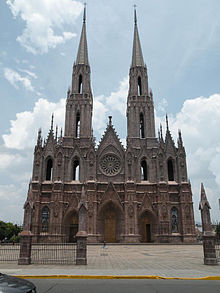
Mexico is a North American country bordering the Caribbean Sea and the Gulf of Mexico, South of the United States and north of Guatemala and Belize. With a total surface area of over 1.9 million square kilometers, Mexico is the 14th largest country in the world. With over 121 million people, Mexico is the 11th most populous country in the world. Approximately 62% of Mexicans are mestizo (Amerindian-Spanish), 21% predominantly Amerindian, 7% Amerindian, with the remaining 10% being mostly European.
Mexico’s Amerindian civilizations – including the Olmec, Toltec, Teotihuacan, Zapotec, Maya, and Aztec – were conquered and colonized by Spain in the early 16th century. The Spanish conquerors carried the smallpox virus, killing from 2-15 million Aztecs. The Spaniards were largely unaffected by the smallpox epidemic and many of the surviving Aztecs blamed their defeat at the hands of the Spaniards on the superiority of the Christian God, which assisted the spread of Catholicism. To assimilate into Spanish colonial society, the Catholic Church sent missionaries to convert, baptize, and educate the indigenous peoples.
In 1810, Miguel Hidalgo, the village priest in the town of Dolores, Guanajuato, called his parishioners to mass and urged them to fight for independence from Spain. The revolutionary movement continued to grow as people also demanded the end of Spanish rule, racial equality, and the redistribution of land. Mexico achieved its independence from Spain in 1821. The transformation from a colony to a self-governing country was difficult, with Mexico having nearly 50 governments in over 30 years, almost all as the result of military coups. Politically, Mexico was deeply divided between the Conservatives who wanted to maintain the old Spanish monarchy model and the Liberals who wanted a federal republic similar to the United States.
In 1857 a new constitution established a secular, federal republic, and in 1858 the Reform Laws were passed, attempting to reduce the power and influence of the Catholic Church by making all Church land and buildings the property of the State,plac[ing] acts pertaining to the civil status of individuals – civil marriages in particular – under public law, and bann[ing] all religious orders.
In 1910, the Mexican Revolution began, with peasants seeking the redistribution of land held by a small group of wealthy landowners. The reigning dictator was ousted in 1911. Following a series of military coups, a new constitution was finally established in 1917 and continues to be amended today.The 1917 constitution outlines a regime that has been described as highly anticlerical, extreme, unfair, and as imposing very severe restrictions on religious associations.These restrictions caused a civil war from 1926 to 1929, which was known as the FCristero War, which ended by an agreement between an interim president and the Catholic Church, with the Cristeros agreeing to lay down their arms, the priests agreeing to resume religious services that had been interrupted, and the government agreeing not to apply the restrictive constitutional provisions.
In 1940, President Manuel Avila Camacho publicly announced that he believed in God.From that time until the constitution was amended in 1992, the restrictive constitutional provisions were not enforced.In 1992, the restrictive constitutional provisions were amended, with the objective of giving de jure recognition to a de facto situation,to promote consistency between what the law decrees and the daily conduct of citizens.
RELIGIOUS CONTEXT
The 2010 census results showed 82.7% of the population were Roman Catholics, 7.5% were Protestant, Evangelical, or Pentecostal Christians, 1.4% were Jehovah’s Witnesses, 0.6% were Seventh-day Adventists, 0.3% were members of The Church of Jesus Christ of Latter-day Saints (Mormons), and less than 0.2% belonged to other, non-Christian religions. Another 4.7% of the population declared having no religion, while 2.7% were unspecified.
In general, religious liberty in Mexico is broadly protected. The Constitution of the United Mexican States (the Constitution) states that all persons have the right to freedom of religion and to engage in ceremonies and acts of worship.The Congress may not enact laws that establish or prohibit any religion.The Constitution also provides for the separation of church and state.However, notwithstanding this generally liberal framework, some members of indigenous communities or minority religions have reported occasional incidents of official religious discrimination at the local level.
For detailed information about the relationshiph of law and religion in Mexico, please see the link below: